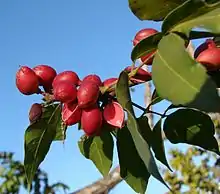| Protium heptaphyllum | |
|---|---|
 | |
| Branch of Protium heptaphyllum | |
| Scientific classification | |
| Kingdom: | Plantae |
| Clade: | Tracheophytes |
| Clade: | Angiosperms |
| Clade: | Eudicots |
| Clade: | Rosids |
| Order: | Sapindales |
| Family: | Burseraceae |
| Genus: | Protium |
| Species: | P. heptaphyllum |
| Binomial name | |
| Protium heptaphyllum (Aubl.) Marchand | |
Protium heptaphyllum, also known as almécega, breu, and almíscar, is a species of tree from South America commonly found in the areas of Brazil, the Guyanas, and Venezuela.[1] The plant is typically harvested by locals for resin, food, wood, and other medical uses.[2]
Description
Protium heptaphyllum is a large, woody tree that is evergreen and can grow to be 10 to 20 meters tall (32 to 65 feet).[2]
Ecology
Protium heptaphyllum has been found to flourish in Amazonia. The biome that this species occupies is the tropical rainforest. This species can be found sandy soils throughout these regions that are wet. Seed dispersal is carried out by animals in these regions, more specifically leaf-cutting ants. These organisms take leaves from the plants to the fungus they share a symbiotic relationship with. This is not only beneficial to the plant, as this helps the plant get its seeds dispersed, but it also helps the ant keep the symbiotic relationship it carries out with their fungus. These ants are also known to be good pollinators for this species.[3] Studies have not been able to fully understand the relationship between this species and the leaf-cutting ants, but it has been proven that they help with seed-dispersal and pollination. Protium heptaphyllum is a subtropical plant, it can resist temperatures up to 4 degrees Celsius.[4]
Cultivation
Protium heptaphyllum is cultivated throughout Brazil, since it is a plant that adapts to sand and clay soils.[3] This species cannot be cultivated in swampy soils or next to rivers where there is constant flooding.[4]
Uses
Fruit in the months from January to March. The fruits have a sweet and refreshing pulp and look like Halls candy, which can be consumed fresh. The tree can be planted in squares and large gardens for producing great shade or in revegetation projects for permanent preservation, aiming to provide food for birds and monkeys. The resin has medicinal and insecticidal properties.[4] The wood has a reddish color and is used in civil constructions, floors, carpentry and joinery, its dense canopy provides ornamental purposes to the plant and can be used in urban or rural areas.[3] P. heptaphyllum also releases chemicals from the resin on its leaves that can be used to create essential oils.[5]
References
- ↑ Lima, Ewelyne M.; Nascimento, Andrews M.; Lenz, Dominik; Scherer, Rodrigo; Meyrelles, Silvana S.; Boëchat, Giovanna A.P.; Andrade, Tadeu U.; Endringer, Denise C. (July 2014). "Triterpenes from the Protium heptaphyllum resin – chemical composition and cytotoxicity". Revista Brasileira de Farmacognosia. 24 (4): 399–407. doi:10.1016/j.bjp.2014.06.003.
- 1 2 "Protium heptaphyllum - Useful Tropical Plants". tropical.theferns.info. Retrieved 5 December 2021.
- 1 2 3 Silva, Paulo D.; Leal, Inara R.; Wirth, Rainer; Tabarelli, Marcelo (September 2007). "Harvesting of Protium heptaphyllum (Aubl.) March. seeds (Burseraceae) by the leaf-cutting ant Atta sexdens L. promotes seed aggregation and seedling mortality". Revista Brasileira de Botânica. 30 (3): 553–560. doi:10.1590/S0100-84042007000300019.
- 1 2 3 Zoghbi, Maria das G. B.; Maia, Jose G. S.; Luz, Arnaldo I. R. (September 1995). "Volatile Constituents from Leaves and Stems of Protium heptaphyllum (Aubl.) March". Journal of Essential Oil Research. 7 (5): 541–543. doi:10.1080/10412905.1995.9698581.
- ↑ Reis Souza, Luiza; Gomes Trindade, Fernanda; Aparecida de Oliveira, Rosilene; Costa, Larissa Corrêa do Bomfim; Moreira Gomes, Valdirene; Da Cunha, Maura (3 March 2016). "Histochemical characterization of secretory ducts and essential oil analysis of Protium species (Burseraceae)". Journal of Essential Oil Research. 28 (2): 166–171. doi:10.1080/10412905.2015.1092478.